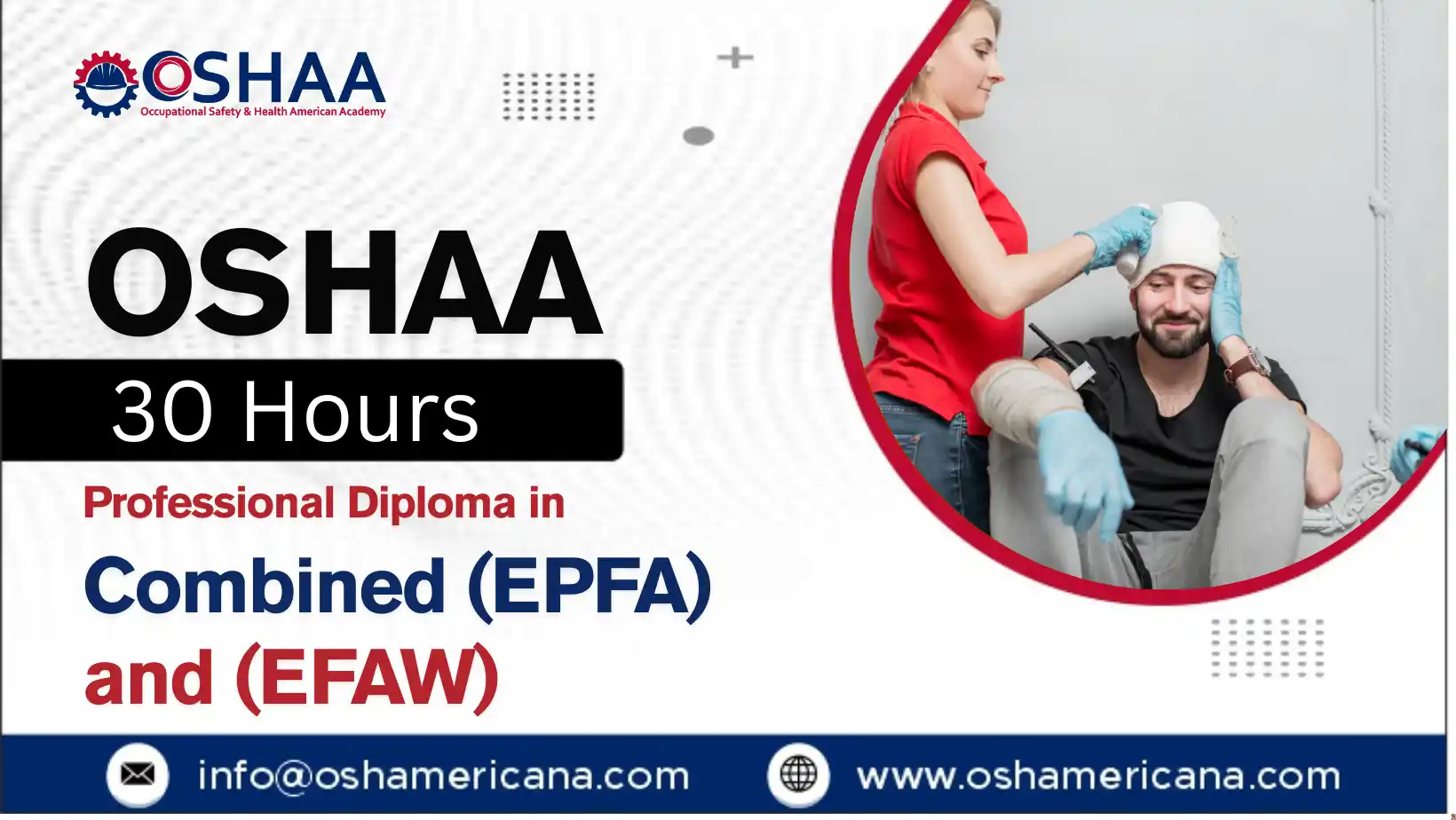The OSHAA 30-Hours Professional Diploma in Combined Emergency Paediatric First Aid (EPFA) and Emergency First Aid at Work (EFAW) is a comprehensive training programme designed to equip participants with essential life-saving skills for both paediatric and adult emergencies. This unique dual qualification blends workplace first aid standards with specialised paediatric emergency response training, ensuring participants are prepared to act confidently in a wide range of critical situations.
Developed and awarded by OSHAA, this diploma meets recognised international standards, making it ideal for those working in environments where both children and adults require safety and care. The course combines theoretical knowledge with practical, hands-on training, allowing participants to develop the competence and confidence needed to respond quickly and effectively during emergencies.
The programme covers a broad range of skills, from initial casualty assessment and incident management to cardiopulmonary resuscitation (CPR) for both children and adults, operation of automated external defibrillators (AEDs), and effective responses to life-threatening conditions. It also provides specialised instruction on managing bleeding, shock, burns, fractures, and other common workplace and paediatric injuries.
Participants will also learn about legal requirements, workplace safety regulations, and emergency preparedness strategies, ensuring they can contribute to a safer environment in both childcare and professional work settings. By integrating emergency paediatric first aid with workplace first aid, the diploma offers a streamlined learning experience without compromising on depth or quality.
On completion of the course, participants will possess a recognised qualification that demonstrates their ability to provide immediate, effective care during critical incidents. Whether in a nursery, school, office, sports facility, or community setting, the skills gained from this diploma can make the difference between life and death in an emergency.
This professional training not only enhances safety and compliance within an organisation but also builds personal confidence in handling unexpected medical situations. The OSHAA 30-Hours Professional Diploma in Combined EPFA and EFAW ensures participants are well-prepared to protect lives across multiple environments, making it an invaluable credential for a wide range of roles and responsibilities.
OSHAA 30-Hours Professional Diploma in Combined Emergency Paediatric First Aid (EPFA) and Emergency First Aid at Work (EFAW)
Study Units
Learning Outcomes
Introduction to First Aid Principles and Legal Responsibilities (2 Hours)
- Understand the fundamental aims and objectives of first aid
- Recognise the legal and ethical responsibilities of a first aider
- Identify workplace and paediatric first aid regulations and compliance requirements
Incident Management and Casualty Assessment for Adults and Children (3 Hours)
- Apply safe and systematic approaches to managing first aid incidents
- Conduct initial casualty assessments to determine the severity of injuries or illnesses
- Prioritise actions based on the condition of the casualty and situation
Primary Survey and Recovery Position Techniques for All Age Groups (3 Hours)
- Perform an effective primary survey on adults, children, and infants
- Safely place a casualty into the recovery position to maintain airway patency
- Adapt recovery position techniques to different age groups and physical conditions
Cardiopulmonary Resuscitation (CPR) and AED Use for Adults, Children, and Infants (5 Hours)
- Perform CPR according to current international guidelines for different age groups
- Safely operate an Automated External Defibrillator (AED) in emergency situations
- Integrate CPR and AED use in a coordinated life-saving response
Management of Unconscious Casualties Across Different Age Groups (4 Hours)
- Identify causes and signs of unconsciousness in adults, children, and infants
- Apply appropriate management techniques to maintain breathing and circulation
- Monitor and provide ongoing care until professional help arrives
Control of Bleeding, Wound Care, and Shock Management (5 Hours)
- Apply various bleeding control techniques, including direct pressure and dressings
- Recognise and treat different types of wounds effectively
- Identify signs of shock and administer appropriate first aid interventions
First Aid for Burns, Scalds, and Thermal Injuries in Workplace and Paediatric Settings (3 Hours)
- Distinguish between different types and severities of burns
- Apply correct cooling and treatment techniques for burns and scalds
- Provide aftercare and monitor for potential complications
Managing Fractures, Sprains, and Soft Tissue Injuries in Adults and Children (3 Hours)
- Recognise the signs and symptoms of fractures, sprains, and strains
- Apply immobilisation techniques to prevent further injury
- Provide effective pain relief measures and comfort to the casualty
Response to Common Medical Emergencies: Asthma, Seizures, and Severe Allergic Reactions (2 Hours)
- Recognise the signs and symptoms of asthma attacks, seizures, and anaphylaxis
- Provide appropriate first aid interventions for each condition
- Support and monitor the casualty until professional medical help is available
- Equips participants with dual qualifications in both Emergency Paediatric First Aid and Emergency First Aid at Work, enhancing professional versatility
- Builds the capability to respond effectively to a wide range of emergencies involving adults, children, and infants
- Strengthens confidence in managing life-threatening situations such as cardiac arrest, severe bleeding, burns, and fractures
- Enhances workplace safety compliance and supports organisational health and safety policies
- Provides practical, hands-on training aligned with current international first aid standards
- Develops the ability to adapt first aid responses to different environments, including childcare, education, and workplace settings
- Increases employability and career opportunities in sectors where first aid knowledge is essential
- Encourages a proactive approach to safety and emergency preparedness in both professional and personal settings
- Participants working in childcare, early years education, or paediatric healthcare settings
- Participants employed in industries or workplaces where emergency first aid is a legal or safety requirement
- Participants seeking dual expertise to handle both workplace and paediatric emergencies effectively
- Participants responsible for safety in community, recreational, or sports environments involving children and adults
- Participants aiming to meet compliance requirements for health and safety regulations
- Participants wishing to gain recognised certification to support professional development and career advancement
- Participants who want to improve their confidence and skills in responding to life-threatening incidents in any environment







